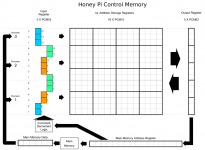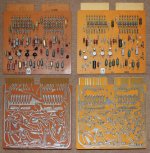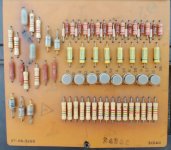Thanks for that info M_T. One of the problems that I had when compiling my own website HoneyPi.org.uk was that very few pictures of the H200 were available and virtually none in colour. In fact when I saw the recent pictures of the control panel in California I wrote to a former Honeywell engineer and asked him to confirm my recollections that the panels were black and white rather than black and yellow. I took a look at the RICM website and there doesn't appear to be any Honeywell equipment mentioned, which isn't unusual.
As with most museums, computer museums probably need to have flexible relationships with conservators as preservation and conservation can have different approaches to working technology as opposed to passive artifacts. Conservation often makes considerable additions of modern material to give an artifact a valid context and this is a good thing provided that the original artifact can be distinguished from those modern additions. My contact in California chose to give me his control panel specifically because I would put it in the right context, albeit a partially contrived one. This is the difficulty where only a few components of a vintage device exist. The main memory of my machine is built using almost all original logic boards with just a few carefully constructed replicas, which are clearly marked as such, and the core memory modules themselves are originals. Hopefully now the control panel will also be an original item. On the other hand I am designing a very different control memory system, but even there I am only using components that Honeywell themselves were using in the 1960s and the control memory will be functionally very similar to the original, especially with regard to the timing of events so that the machine performs exactly as the original would have.
Elsewhere here someone recently asked in another thread what he should do with an IBM 360 control panel that he found in his loft. He could keep it as a conservation piece for his lounge and configure the lights to flash like Christmas decorations or sell or give it to a collector or museum. On the thread suggestions were posted about its potential value, no doubt to encourage him to keep it in its original condition until it found a "good" home. What are the best homes for such items though? Is a glass case in a museum better than the Frankensteinian laboratory of a hardware hacker like myself? When I eventually stagger out of my workshop a much older man after years of toil gabbling "It lives!" will anyone thank me? I have little idea. My project was conceived to turn a pile of junk, that I would have to pay good money to get recycled under our British Waste Electrical and Electronic Equipment Regulations, into something that might have a positive value. I have joined our national Computer Conservation Society, which actually specialises in the conservation and replication of vintage British computers, to get some insight into the practicalities of good practice in this activity, but the reality is that there is a lot of Frankensteinian hacking necessary that museum curators might wince at. Our national CCS actually works in close connection with our National Museum of Computing at Bletchley Park, arguably the historical home of practical computing, if war can ever be viewed as a practical activity. It is an interesting question in general, what we are really trying to achieve here apart from getting some amusement out of old pieces of what others might see as junk.
Years ago I mentioned to someone who used the working IBM 1401 machine in the Computer History Museum in California that the daughter of the chief designer of the Honeywell 200 was sending her late father's personal papers, copies of some of which she sent to me, to the museum to put in their archives and his response was "Nobody will ever get to see them again then." The question is whether museums run the risk of preserving just the bodies of such past entities for posterity without also preserving their spirits as we try to do with our reconstructions and emulations.
Here endeth the sermon to the converted. Back to the work in hand then and thanks again for aiming to get that picture posted.



